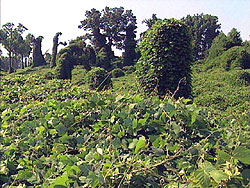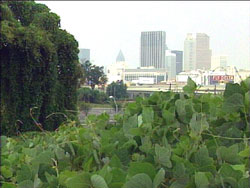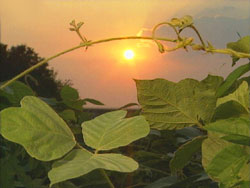 |
In Georgia, the legend says That you must close your windows At night to keep it out of the house. The glass is tinged with green, even so... From the poem, "Kudzu," |
The Amazing Story of Kudzu
Love It, Or Hate It... It Grows On You!
 |
In Georgia, the legend says That you must close your windows At night to keep it out of the house. The glass is tinged with green, even so... From the poem, "Kudzu," |
There's so much of this fast-growing vine in the Southeastern U.S., you might think it was a native plant. Actually, it took a lot of hard work to help kudzu spread so widely. Now that it covers over seven million acres of the deep South, there are a lot of people working hard to get rid of it! But kudzu is used in ways which might surprise you...
Kudzu's History:
Up and Down the Power Pole
Kudzu was introduced to the United States in 1876 at the Centennial Exposition in Philadelphia, Pennsylvania. Countries were invited to build exhibits to celebrate the 100th birthday of the U.S. The Japanese government constructed a beautiful garden filled with plants from their country. The large leaves and sweet-smelling blooms of kudzu captured the imagination of American gardeners who used the plant for ornamental purposes.
Florida nursery operators, Charles and Lillie Pleas, discovered that animals would eat the plant and promoted its use for forage in the 1920s. Their Glen Arden Nursery in Chipley sold kudzu plants through the mail. A historical marker there proudly proclaims "Kudzu Developed Here."
During the Great Depression of the 1930s, the Soil Conservation Service promoted kudzu for erosion control. Hundreds of young men were given work planting kudzu through the Civilian Conservation Corps. Farmers were paid as much as eight dollars an acre as incentive to plant fields of the vines in the 1940s.
![]()
"Cotton isn't king in the South anymore.
Kudzu is king!"
Channing Cope
![]()
 Kudzu's most vocal advocate was Channing Cope of
Covington, Georgia who promoted use of the vine to control erosion. Cope wrote about kudzu
in articles for the Atlanta Journal-Constitution and talked about its virtues
frequently on his daily WSB-AM radio program broadcast from his front porch. During
the 1940s, he traveled across the southeast starting Kudzu Clubs to honor what he called
"the miracle vine."
Kudzu's most vocal advocate was Channing Cope of
Covington, Georgia who promoted use of the vine to control erosion. Cope wrote about kudzu
in articles for the Atlanta Journal-Constitution and talked about its virtues
frequently on his daily WSB-AM radio program broadcast from his front porch. During
the 1940s, he traveled across the southeast starting Kudzu Clubs to honor what he called
"the miracle vine."
Cope was very disappointed when the U.S. government stopped
advocating the use of kudzu in 1953.
Kudzu Control:
An Impossible Dream?
The problem is that it just grows too well! The climate of the Southeastern U.S. is perfect for kudzu. The vines grow as much as a foot per day during summer months, climbing trees, power poles, and anything else they contact. Under ideal conditions kudzu vines can grow sixty feet each year.
While they help prevent erosion, the vines can also destroy valuable forests by preventing trees from getting sunlight. This problem led Dr. James H. Miller of the U.S. Forest Service in Auburn, Alabama to research methods for killing kudzu. In eighteen years of research, he has found that one herbicide actually makes kudzu grow better while many have little effect. Miller recommends repeated herbicide treatments for at least four years, but some kudzu plants may take as long as ten years to kill, even with the most effective herbicides.
![]()
The USDA declared kudzu to be a weed in 1972!
![]()
Dr. Errol G. Rhoden, along
with other researchers at Tuskegee University, has successfully raised Angora goats in
fields of kudzu which would otherwise be considered wasted land. The goats keep the kudzu
from spreading further while producing profitable milk and wool products. Rhoden says
constant grazing will eventually eradicate kudzu. If kudzu is to provide a continuing food
source, animals must be removed from the fields occasionally to allow the vines time to
grow.
![]()
Common names for kudzu include:
mile-a-minute vine,
foot-a-night vine,
and the vine that ate the South.
![]()
Current research may lead to new medicines made from kudzu, but for now only hamsters and mice can benefit from these drugs. Research with laboratory animals at Harvard Medical School has revealed that a drug extracted from kudzu root may help in the treatment of alcoholism. The drug is based on a 2,000 year old Chinese herbal medicine. Several years of testing may be required before the drug can be made available for human consumption.
 In China and Japan, ground kudzu root (called kuzu) has been a common
ingredient in foods and medications for centuries. Kudzu is respected and enjoyed there.
It's far more versatile than say, turnips. But kudzu grows better in the South than it
does in its native lands. Its natural insect enemies were not brought to the U.S. with it.
In China and Japan, ground kudzu root (called kuzu) has been a common
ingredient in foods and medications for centuries. Kudzu is respected and enjoyed there.
It's far more versatile than say, turnips. But kudzu grows better in the South than it
does in its native lands. Its natural insect enemies were not brought to the U.S. with it.
That's why visitors to the South are sometimes awe-struck by scenic vistas which reveal miles and miles of seemingly endless vines.
Southerners just close their windows at night to keep the
kudzu out.
![]() The Kudzu Collection is Dave Lineback's
wonderful gallery of photographs showing North Carolina kudzu at its best.
The Kudzu Collection is Dave Lineback's
wonderful gallery of photographs showing North Carolina kudzu at its best.
![]() Kudzu-The Vine is Jack Anthony's
collection of photos featuring various north Georgia structures covered by kudzu.
Kudzu-The Vine is Jack Anthony's
collection of photos featuring various north Georgia structures covered by kudzu.
![]()
Source; The University of Alabama Center for Public Television & Radio